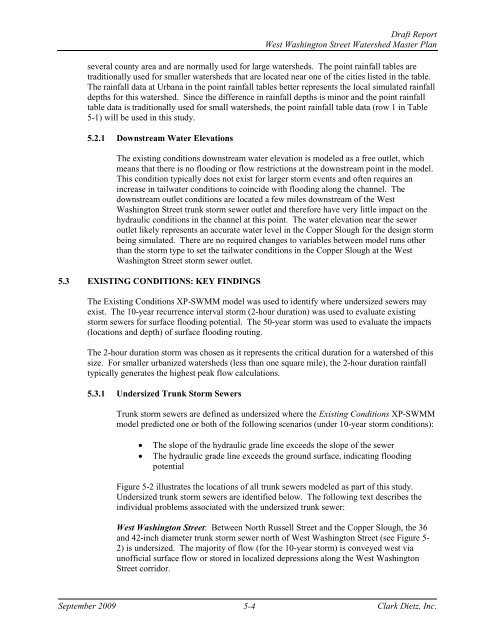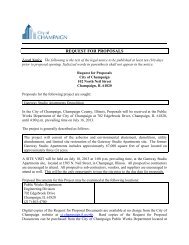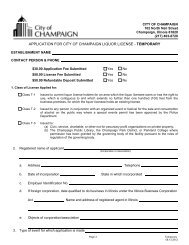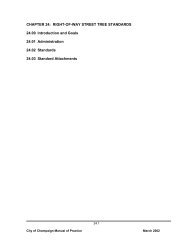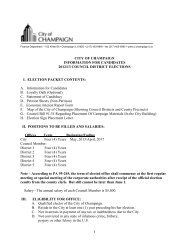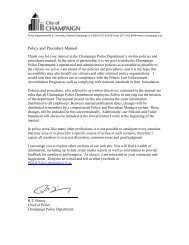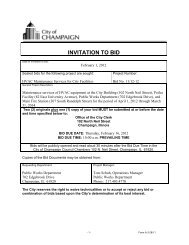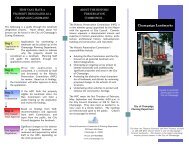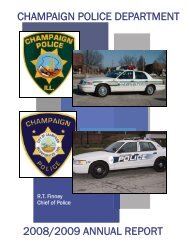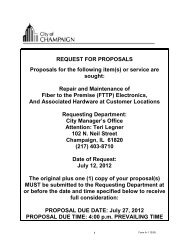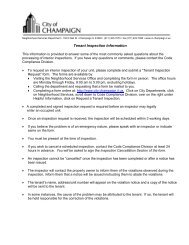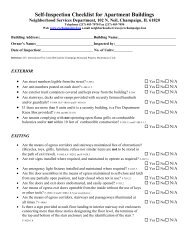Washington Street West watershed - City of Champaign
Washington Street West watershed - City of Champaign
Washington Street West watershed - City of Champaign
- No tags were found...
Create successful ePaper yourself
Turn your PDF publications into a flip-book with our unique Google optimized e-Paper software.
Draft Report<strong>West</strong> <strong>Washington</strong> <strong>Street</strong> Watershed Master Planseveral county area and are normally used for large <strong>watershed</strong>s. The point rainfall tables aretraditionally used for smaller <strong>watershed</strong>s that are located near one <strong>of</strong> the cities listed in the table.The rainfall data at Urbana in the point rainfall tables better represents the local simulated rainfalldepths for this <strong>watershed</strong>. Since the difference in rainfall depths is minor and the point rainfalltable data is traditionally used for small <strong>watershed</strong>s, the point rainfall table data (row 1 in Table5-1) will be used in this study.5.2.1 Downstream Water ElevationsThe existing conditions downstream water elevation is modeled as a free outlet, whichmeans that there is no flooding or flow restrictions at the downstream point in the model.This condition typically does not exist for larger storm events and <strong>of</strong>ten requires anincrease in tailwater conditions to coincide with flooding along the channel. Thedownstream outlet conditions are located a few miles downstream <strong>of</strong> the <strong>West</strong><strong>Washington</strong> <strong>Street</strong> trunk storm sewer outlet and therefore have very little impact on thehydraulic conditions in the channel at this point. The water elevation near the seweroutlet likely represents an accurate water level in the Copper Slough for the design stormbeing simulated. There are no required changes to variables between model runs otherthan the storm type to set the tailwater conditions in the Copper Slough at the <strong>West</strong><strong>Washington</strong> <strong>Street</strong> storm sewer outlet.5.3 EXISTING CONDITIONS: KEY FINDINGSThe Existing Conditions XP-SWMM model was used to identify where undersized sewers mayexist. The 10-year recurrence interval storm (2-hour duration) was used to evaluate existingstorm sewers for surface flooding potential. The 50-year storm was used to evaluate the impacts(locations and depth) <strong>of</strong> surface flooding routing.The 2-hour duration storm was chosen as it represents the critical duration for a <strong>watershed</strong> <strong>of</strong> thissize. For smaller urbanized <strong>watershed</strong>s (less than one square mile), the 2-hour duration rainfalltypically generates the highest peak flow calculations.5.3.1 Undersized Trunk Storm SewersTrunk storm sewers are defined as undersized where the Existing Conditions XP-SWMMmodel predicted one or both <strong>of</strong> the following scenarios (under 10-year storm conditions):• The slope <strong>of</strong> the hydraulic grade line exceeds the slope <strong>of</strong> the sewer• The hydraulic grade line exceeds the ground surface, indicating floodingpotentialFigure 5-2 illustrates the locations <strong>of</strong> all trunk sewers modeled as part <strong>of</strong> this study.Undersized trunk storm sewers are identified below. The following text describes theindividual problems associated with the undersized trunk sewer:<strong>West</strong> <strong>Washington</strong> <strong>Street</strong>: Between North Russell <strong>Street</strong> and the Copper Slough, the 36and 42-inch diameter trunk storm sewer north <strong>of</strong> <strong>West</strong> <strong>Washington</strong> <strong>Street</strong> (see Figure 5-2) is undersized. The majority <strong>of</strong> flow (for the 10-year storm) is conveyed west viaun<strong>of</strong>ficial surface flow or stored in localized depressions along the <strong>West</strong> <strong>Washington</strong><strong>Street</strong> corridor.September 20095-4Clark Dietz, Inc.


